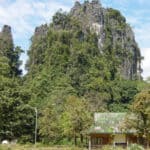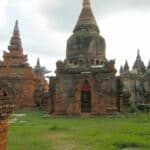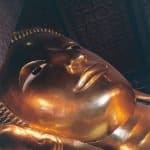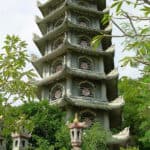Visiting the Shwedagon pilgrimage site

Today in the afternoon I visited the Shwedagon pagoda where I had an unexpected Buddhist initiation. Without any debate, this temple is unquestionably the most significant in Myanmar. It contains one massive stupa covered with gold leaves, and around it, you have numerous other temples and shrines, showcasing unique architectural styles. The complex is a representative pilgrimage site for the Burmese, with a serene atmosphere for visitors to explore and experience the spiritual aura of the place. And it is very easy and even recommended to reserve enough of your time to visit this religious highlight. I would suggest dedicating at least half a day to explore the various places of interest.

Guided Buddhist initiation
While I am walking at the complex, at a particular moment, a monk addresses me. His English is rather good. When he finds out on which day I was born, he takes me to the Monday Buddha. To have a good life, or in case I have worries which I want to get rid of, I have to perform a Buddhist initiation. Even though I do not consider myself a Buddhist, I will find peace and prosperity, and all my troubles will vanish, he tells me.
Ritual at her Monday-Buddha
The Buddhist ritual involves several steps. Initially, I must pour water over the head of the Buddha statue nine times, followed by pouring water seven times over the tiger statue next to it, and finally five times over the Buddha statue located behind it. I carefully follow the instructions, paying close attention to how the Burmese perform these actions. Overall, it is an enjoyable experience for me.

Gaining merit

Then the monk guides me to a massive bronze bell, reputed to have a weight of 42 tons. Following instructions, I am required to tap the bell five times with a wooden bell clapper. That should yield merit; for Buddha, karma, sangha, knowledge, and my parents. Afterward, we visit a footprint of Buddha – containing 108 religious symbols. Sacred water flows over the print.
To finish the Buddhist initiation I must sprinkle my face with this holy water, and then pour five cups of water over the nose of the accompanying naga (a mythical snake). Completing the whole Buddhist ritual will bring me a good life and make my wishes come true. My thought is that even if it does not have a positive impact, it won’t cause any negative repercussions either.
The most important Buddhist relics at Shwedagon
My guide further shows me the most essential Buddhist relics of the Shwedagon temple complex. To illustrate, there is a cave more than 40 meters deep in which the eight donated hairs of Buddha have been washed. Additionally, there is a radiant Buddha sculpture adorned with precious diamonds and gemstones. Moreover, we pay homage to the Buddha with the eye of a goat and a cow, and finally encounter a Buddha flanked by a tiger and a lion; these animals are believed to offer protection against your enemies.

Is a monk allowed to accept payments?
In itself, this guided Buddhist initiation is a fascinating experience, though it comes to a slightly disappointing end for me. I am surprised when the monk requests a large sum of money for his services, as I didn’t realize monks were allowed to accept payments. After my initial surprise, I do give him some money but not the amount he wants. Thankfully, he accepts my offer without any argument, and we part ways on good terms.
Fortune or chance at dark
While walking back to the hotel, there is another general power outage. This happens at least 2 or 3 times daily in Yangon. As it is already dark, with numerous broken-up pavements, I step into a gap in the road. Luckily without too many consequences. My ankle gets bruised slightly, but I can still walk without too much pain. Fortune or chance, who can say? My Burmese adventure could have already ended today with a broken foot alike.







